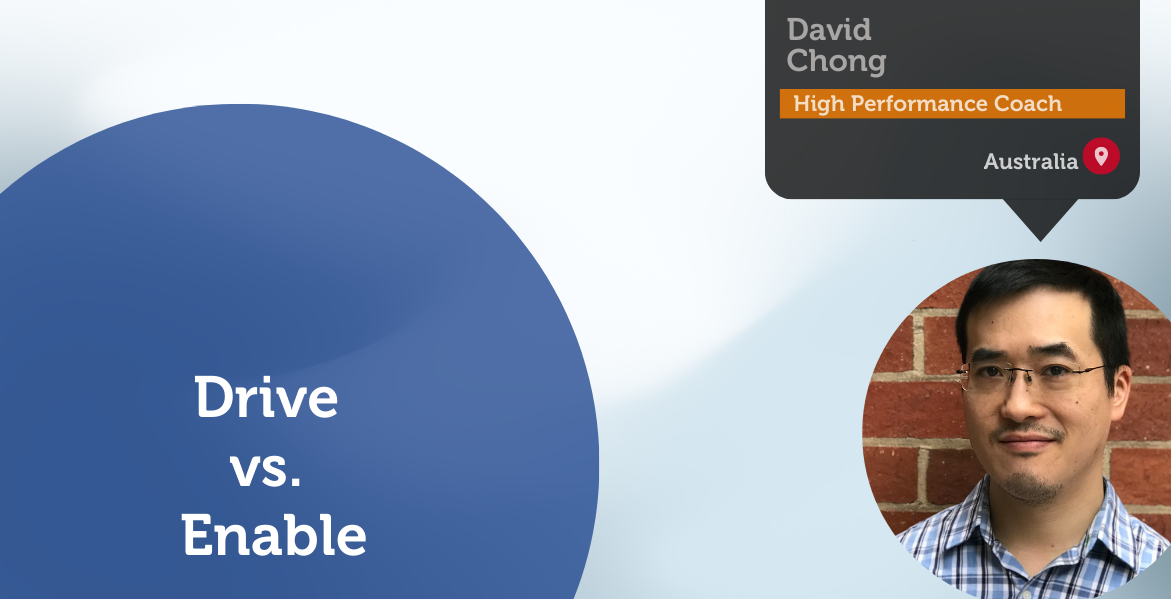A Coaching Power Tool By David Chong, High Performance Coach, AUSTRALIA

The Drive vs. Enable Power Tool
Change is the only constant in life.- Heraclitus, the Greek philosopher
In today’s corporate landscape, many key business functions are increasingly outsourced and offshored in pursuit of cost reduction and resource efficiency. However, this approach is inadvertently leading to fragmented workflows within organizations, hindering communication and impeding the speed to market for customers.
This shift away from prioritizing “customer collaboration” in favor of “contract negotiation” has undesirable consequences. It promotes micromanagement and a command-and-authority culture, eroding trust and resulting in an excessive management hierarchy.
This Power Tool seeks to present an alternative approach, particularly suited for large corporate environments. Instead of solely focusing on driving efficiency, change, and delivery, it advocates for creating an empowering environment. By enabling individuals to reach their goals and fostering collaboration, this approach can yield remarkable outcomes for the organization.
Drive vs. Enable Explanation:

Picture this: In a boat, three people are yelling at one individual who’s rowing, pushing, and driving them relentlessly to achieve a goal. Now, imagine another scenario where four people are rowing together, supporting and motivating each other towards a common objective.
The former situation represents the traditional approach of being a “change driver,” where new processes and tools are forced onto people, often leading to a demoralizing experience. In this approach, individuals are treated merely as numbers, referred to as “resources” to deliver outputs. On the other hand, the concept of a “change enabler” involves inspiring people to embrace change willingly, rather than imposing it upon them.
What Is a Change Driver?
Definition:
A Change Driver relies on telling people what to do. They use negative emotions, such as authority and manipulation to enforce an agenda.
Their beliefs:
- I have to push and drive my team to achieve the goal
- If I’m not taking charge, being the “boss”, and telling people what to do, then:
- Things will not progress and the schedule will slip
- I won’t feel important
- My team will slack off unless I monitor and manage them closely.
- Assumes the typical worker:(Theory X work motivation & management style)
- Dislike work and avoid it
- Prefer to be directed by others
- Avoid responsibility
- Are extrinsically motivated
- Require supervision &control
- Must be coerced to perform
What does it look like:
- The engineering team has an issue, management wants results and puts pressure on engineering with more status reporting and meetings. This slows down engineering even more, making the situation worsen.
- Turns creative & innovative problem solvers into compliant workers delivering the bare minimum and lower quality work.
- High turnover of employees
What Is a Change Enabler?
Definition:
A change enabler does not push against resistance, instead, they listen and trust building so that people are drawn, and have the desire to change. There is no or minimal resistance.
Their Beliefs:
- I get to co-create & inspire my team to achieve the goal.
- My team wants to be at work and do their best.
- I only need to give them clear goals and then just support them to get there (i.e.servant leadership)
- We hire smart people and let them tell us how to get the work done
- Assumes the typical worker:(Theory Y work motivation & management style)
-
- Take an interest in work
- Are creative problem-solves
- Seek and accept responsibility
- Are intrinsically motivated
- Can exercise self-direction and self-control
What does it look like:
- Purpose-driven and motivated people
- High-quality work
- Loyalty with low staff turnover
The Long-Term Impact of Driving vs. Enabling:
“Driving” versus “Enabling” refers to two distinct leadership approaches with contrasting outcomes for individuals or teams. “Driving” involves providing explicit instructions and prescriptive solutions to address immediate problems, resulting in solving short-term issues. However, this approach often fails to tackle underlying, long-term problems effectively. While it may result in compliance and a quick fix, it fosters a culture of dependence on the leader, stifling individual development and growth within the team.
On the other hand, “Enabling” focuses on empowering individuals or teams to explore what is possible and encourages them to think critically and creatively. Instead of providing step-by-step solutions, leaders enable their teams and inspire them to come up with their own ideas and strategies for problem-solving. This approach fosters a culture of challenging thinking and continuous improvement. As a result, the team becomes more self-organizing, engaging actively in the decision-making process, and striving for mastery in their respective roles.
The long-term impact of the “Enabling” approach is a team that is not only capable of addressing immediate challenges but also equipped with the skills and mindset to handle complex and unexpected issues that may arise in the future. It nurtures long-term development and growth within the team members, fostering a sense of ownership and accountability in their work. In contrast to the “Driving” approach, “Enabling” promotes a more sustainable and adaptable team dynamic, where individuals feel motivated to take initiative and actively contribute to the overall success of the team.
How to Shift From Drive to Enable
Establishing a Foundation for Change
To initiate a successful shift from Drive to Enable, a healthy relationship must first be established. In any organization or personal setting, trust is the bedrock upon which effective communication and collaboration are built. A safe environment must be cultivated, where individuals feel comfortable expressing their thoughts and opinions without fear of judgment. The presence of trust allows for open dialogue and an honest exchange of ideas.
Next, a strong desire for change is vital to fuel the motivation needed to overcome obstacles and challenges. Employing the widely recognized change management concept of creating a “burning platform” ensures that leaders grasp the significance and urgency of the proposed changes, becoming fully invested in the transformation process.
The Enabler Coaching Process
Enabler coaching is a supportive and empowering approach that guides individuals through the process of change. It involves asking thought-provoking questions that encourage introspection and self-discovery. Below are some coaching questions to initiate the change process:
- What is pushing you forward?
- What is holding you back?
- What would it mean to not have that obstacle?
- What is possible without it?
- What needs to happen for that obstacle to be removed?
- What else, what other options are there?
By reflecting on these questions, individuals gain insights into their motivations, fears, and potential solutions. They can develop a clear understanding of what drives them forward and identify the barriers hindering their progress. Through this process, they begin to perceive the possibilities that lie ahead and recognize the steps required to remove obstacles.
Top Tips for Subtle Coaching Within an Organisation:
Subtly change the words/language: The choice of words can significantly impact how individuals perceive and respond to coaching.
- Avoid using Red List words such as “Mandate,” “Directive,” “Sell,” “Tell,” “Push,” and “Convince,” as they can create resistance and stifle growth.
- Embrace Green List words such as “Invite,” “Co-create,” “Optional,” “Pull,” “Listen,” and “Inspire,” which support growth and invite collaboration without resistance.
When you face resistance from individuals… Stop. Confirm your relationship is still healthy, and the desire for change is still strong, and then reassess your language and shift to the green list of words. This change in approach can break down barriers and encourage individuals to be more receptive to new ideas and initiatives.
Let go of personal agendas: When coaching others, it is essential to set aside personal agendas or preconceived solutions/ideas. Letting go of your own biases allows space for freedom, invitation, and choice. By recognizing that you are both part of the problem and the solution, you can create an environment that fosters open dialogue, and collaboration and encourages individuals to take ownership of the change process.
Yesterday I was clever so I wanted to change the world. Today I’m am wise, so I am changing myself- Rumi
Adopting an enabling coaching approach empowers individuals to become catalysts for positive change, leading to a more thriving and adaptive organization.
Drive vs. Enable Step-By-Step Summary
As coaches, our goal is to empower individuals and teams rather than impose change upon them. We achieve this by asking powerful questions that inspire self-discovery and encourage intrinsic motivation. Here’s a step-by-step summary of the coaching application:
- Establish intentions: As coaches, openly communicate to the team that the intention is not to force change but to empower them through coaching.
- Ask thought: Provoking questions to guide individuals toward their goals and potential.
Examples include:
- What does good look like? (Envisioning the desired outcome)
- What is stopping you from achieving that goal? (Identifying obstacles)
- What is holding you back? (Recognising personal barriers)
- What would be possible if this obstacle didn’t exist? (Uncovering possibilities)
- What is one thing you can do differently to get you closer? (Encouraging actionable steps)
Reflection Questions:
Does being an enabler work?
- Implementing change (in self and others) is hard. It is only when there is stress and challenges that the new behavior is put to the test. Will the new habits prevail, or will old habits return…
- Like building strength at the gym, start on small/light weights and build up muscle and confidence before jumping into the heavier weights.
- Most of all, persist and be optimistic
What kind of emotions are you using to motivate yourself and/or your team?
- Negative emotions – fear, stress, insecurity, guilt
- Positive emotions – empath, curiosity, creativity, passion, purpose
References
Modig, N. & Åhlström, P. (2012) This is lean: resolving the efficiency paradox, Stockholm, Rheologica publ.
Chamine, S. (2016)Positive Intelligence, Greenleaf Book Group Press
How to Overcome Resistance in Your Agile Transformation – The Power of Invitation | Shift314 Evolve Performance
Theory X and Theory Y – Understanding People’s Motivations | Mindtools
Wille, P. (2020) Strong Product People: A Complete Guide to Developing Great Product Managers.
Manifesto for Agile Software Development |agilemanifesto.org